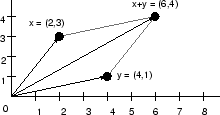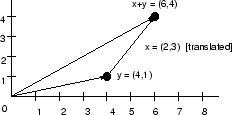NOTE: THIS DOCUMENT IS OBSOLETE, PLEASE CHECK THE NEW VERSION: "Mathematics of the Discrete Fourier Transform (DFT), with Audio Applications --- Second Edition", by Julius O. Smith III, W3K Publishing, 2007, ISBN 978-0-9745607-4-8. - Copyright © 2017-09-28 by Julius O. Smith III - Center for Computer Research in Music and Acoustics (CCRMA), Stanford University
<< Previous page TOC INDEX Next page >>
Vector Addition
Given two vectors in
, say
and
, the vector sum is defined byelementwise addition. If we denote the sum by
, then we have
for
.
The vector diagram for the sum of two vectors can be found using the parallelogram rule, as shown in Fig. 6.2 for
,
, and
.
Also shown are the lighter construction lines which complete the parallelogram started by
and
, indicating where the endpoint of the sum
lies. Since it is a parallelogram, the two construction lines are congruent to the vectors
and
. As a result, the vector sum is often expressed as a triangle by translating the origin of one member of the sum to the tip of the other, as shown in Fig. 6.3.
In the figure,
was translated to the tip of
. It is equally valid to translate
to the tip of
, because vector addition is commutative, i.e.,
=
.

